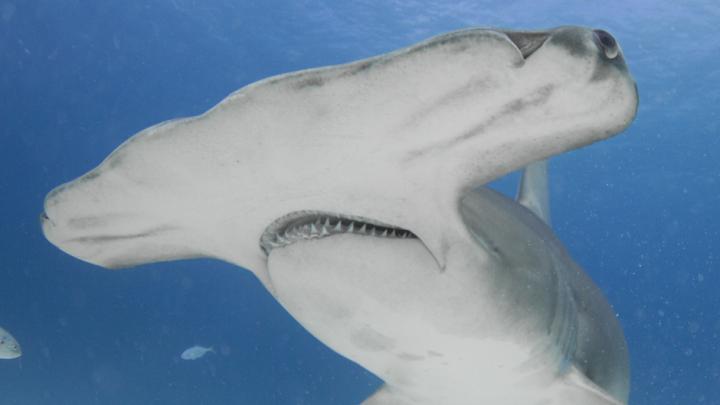New study highlights shark protections, vulnerability to fishing

Great hammerhead sharks are considered overfished and are experiencing population declines in the subtropical Atlantic Ocean and Gulf of Mexico. Credit: Neil Hammerschlag, Ph.D., University of Miami Rosenstiel School of Marine and Atmospheric Science
A new analysis shows that the habitats of three shark species (great hammerhead, tiger, and bull sharks) are relatively well protected from longline fishing in federal waters off the southeastern United States, but that that some prime locations are still vulnerable to fishing.
The new study led by scientists at the University of Miami (UM) Rosenstiel School of Marine and Atmospheric Science has important implications to further protect these at-risk species from unintentional fishing, known as bycatch, in U.S. federal waters.
Great hammerhead sharks are considered overfished and are experiencing population declines in the subtropical Atlantic Ocean and Gulf of Mexico. Tiger and bull shark populations have experienced declines to a lesser extent in the region over the past several decades and their populations appear to be stabilizing at present.
The research team analyzed data from 96 tagged great hammerheads, tiger, and bull sharks to create habitat suitability models that reveal specific areas where these sharks are most likely to occur due to favorable environmental conditions. These 'highly suitable habitats' were then compared to areas where longline fishing gear is currently prohibited to determine what proportion of their habitats are protected from, and vulnerable to, longline fishing activity.
The analysis showed that highly suitable habitats overlapping with the longline fishing restricted areas varied by species and season. Highly suitable habitats of great hammerheads and tiger sharks were relatively well protected from pelagic longlines yet vulnerable to bottom longline fishing. In addition, both species were vulnerable to pelagic and bottom longline fishing off southwestern Florida. Accordingly, the researchers suggested that extending longline gear restrictions to this area may benefit both great hammerhead and tiger sharks species.
“This study highlights the importance of considering seasonal trends in habitat use and movement patterns as these can vary greatly throughout the year and may impact the effectiveness of management plans for these species,” said the study's lead author Hannah Calich, a UM Rosenstiel School alumna and current Ph.D. student at the University of Western Australia.
“Given the wide ranging movements of many migratory marine animals, the extent to which management areas protect their key habitats is often unknown and certainly very challenging to determine,” said Neil Hammerschlag, a Research Associate Professor at UM's Rosenstiel School and study co-author. “We hope our approach will be helpful to researchers working with other migratory species, such as billfish, turtles, whales, seals, and tunas, to better help address these conservation issues.”
###
The study, titled “Overlap between habitat suitability and longline gear management areas reveals vulnerable and protected habitats for highly migratory sharks,” was published on Aug. 23 in the journal Marine Ecology Progress Series. https:/
The study's authors include: Hannah Calich, Maria Estevanez and Neil Hammerschlag from the UM Rosenstiel School of Marine and Atmospheric Science.
The research was supported by The Batchelor Foundation, Disney Conservation Fund, Wells Fargo, Guy Harvey Ocean Foundation, and the West Coast Inland Navigation District.
About the University of Miami's Rosenstiel School
The University of Miami is one of the largest private research institutions in the southeastern United States. The University's mission is to provide quality education, attract and retain outstanding students, support the faculty and their research, and build an endowment for University initiatives. Founded in the 1940's, the Rosenstiel School of Marine & Atmospheric Science has grown into one of the world's premier marine and atmospheric research institutions. Offering dynamic interdisciplinary academics, the Rosenstiel School is dedicated to helping communities to better understand the planet, participating in the establishment of environmental policies, and aiding in the improvement of society and quality of life. For more information, visit: http://www.
Media Contact
All latest news from the category: Life Sciences and Chemistry
Articles and reports from the Life Sciences and chemistry area deal with applied and basic research into modern biology, chemistry and human medicine.
Valuable information can be found on a range of life sciences fields including bacteriology, biochemistry, bionics, bioinformatics, biophysics, biotechnology, genetics, geobotany, human biology, marine biology, microbiology, molecular biology, cellular biology, zoology, bioinorganic chemistry, microchemistry and environmental chemistry.
Newest articles

First-of-its-kind study uses remote sensing to monitor plastic debris in rivers and lakes
Remote sensing creates a cost-effective solution to monitoring plastic pollution. A first-of-its-kind study from researchers at the University of Minnesota Twin Cities shows how remote sensing can help monitor and…

Laser-based artificial neuron mimics nerve cell functions at lightning speed
With a processing speed a billion times faster than nature, chip-based laser neuron could help advance AI tasks such as pattern recognition and sequence prediction. Researchers have developed a laser-based…

Optimising the processing of plastic waste
Just one look in the yellow bin reveals a colourful jumble of different types of plastic. However, the purer and more uniform plastic waste is, the easier it is to…



